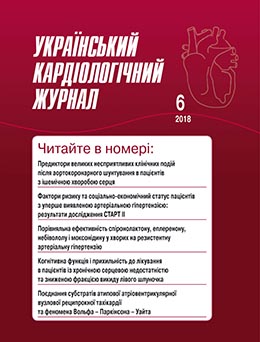Influence of statins on indicators of immune inflammation depending on their baseline level in patients with stable coronary heart disease
Main Article Content
Abstract
The aim – to determine the effect of statins upon parameters of immune inflammation, depending on their initial disturbances in patients with stable coronary artery disease.
Material and methods. 54 patients with stable angina pectoris were examined. Venous blood was taken before and after two months of treatment with atorvastatin (20 mg/day) (n=22) or lovastatin (40 mg/day) (n=12) or simvastatin
(40 mg/day) (n=20). Immunological parameters such as TNF-α, IL-6, IL-8, IL-10, high-sensitivity CRP, antibodies to low-density oxidized lipoproteins, number of cells with CD40 receptors, functional-metabolic activity of neutrophils and monocytes, and subpopulations of lymphocytes were determined.
Results. Two-month statin administration in equivalent doses led to a moderate decrease in the synthesis of mononuclear cells of proinflammatory cytokines (TNF-α, IL-8) and decrease of functional activity of monocytes in the general group of patients with stable coronary heart disease. The influence of statins on humoral and cellular factors of immune inflammation directly depended on the initial factor level (R=0,32–0,77; Р=0,04–0,00001).
Сonclusions. Statins affect the adaptive and innate links of immunity in patients with stable ischemic heart disease. The effect of statins on humoral (CRP, ТNF-α, IL-6, IL-8, IL-10) and cellular (monocytes, Th, Ts, Th/Ts) factors of immune inflammation in patients with IHD directly depends on the initial level of the factor. The more the initial level of the indicator is changed relative to the control, the greater the normalizing effect of the same dose of statins.
Article Details
Keywords:
References
ACCORD Study Group: Effects of combination lipid therapy in type 2 diabetes mellitus. N. Engl. J. Med. 2010;362:1563–1574.
Athyros VG, Mikhailidis DP, Liberopoulos EN, Kakafika AI, Karagiannis A, Papageorgiou AA, Tziomalos K, Ganotakis ES, Elisaf M. Effect of statin treatment on renal function and serum uric acid levels and their relation to vascular events in patients with coronary heart disease and metabolic syndrome: a subgroup analysis of the GREek Atorvastatin and Coronary heart disease Evaluation (GREACE) Study. Nephrol. Dial. Transplant. 2007;22:118–127https://www.ncbi.nlm.nih.gov/pubmed/16998214.
Fernandez-Botran R, Vetvicka V. Advanced Methods in Cellular Immunology. CRC Press. 2000.192 p.
Park B, Fikring S, Smithwick B. Infection and nitrobluetetrazolium reduction by neutrophils. The Lancet. 1988;2:532–534.
Robins SJ, Collins D, Wittes JT, Papademetriou V, Deedwania PC, Schaefer EJ, McNamara JR, Kashyap ML, Hershman JM, Wexler LF, Rubins HB; VA-HIT Study Group. Veterans Affairs High-Density Lipoprotein Intervention Trial. VA-HIT Study Group: Relation of gemfibrozil treatment and lipid levels with major coronary events: VA-HIT: a randomized controlled trial. JAMA. 2001;285:1585–1591 https://www.ncbi.nlm.nih.gov/pubmed/11268266.
Sacks F, Carey V, Fruchart J. Combination lipid therapy in type 2 diabetes. N. Engl. J. Med. 2010;363:692–694.
Scott R, O'Brien R, Fulcher G, Pardy C, D'Emden M, Tse D, Taskinen MR, Ehnholm C, Keech A; Fenofibrate Intervention and Event Lowering in Diabetes (FIELD) Study Investigators. Fenofibrate Intervention and Event Lowering in Diabetes (FIELD) Study Investigators: Effects of fenofibrate treatment on cardiovascular disease risk in 9,795 individ¬uals with type 2 diabetes and various components of the metabolic syn¬drome: the Fenofibrate Intervention and Event Lowering in Diabetes (FIELD) study. Diabetes Care. 2009 Mar;32(3):493–8. doi: 10.2337/dc08-1543
Sharma A, Wagner T, Marsalek P. Moxonidine in the treatment overweight and obese patients with the metabolic syndrome: a postmarketing surveillance study. J.Hum. Hypertens. 2004;9:666–675.
Shepherd J, Barter P, Carmena R, Deedwania P, Fruchart JC, Haffner S, Hsia J, Breazna A, LaRosa J, Grundy S, Waters D. Effect of lowering LDL cholesterol substantially below currently recommended levels inpa-tients with coronary heart disease and diabetes. The Treating to New Targets (TNT) study. Diabetes Care. 2006;29:1220–1226 https://www.ncbi.nlm.nih.gov/pubmed/16731999.
Shigematsu E, Yamakawa T, Taguri M, Morita S, Tokui M, Miyamoto K, Funae O, Takatuka Y, Kadonosono K, Shigematsu H, Terauchi Y. Efficacy of Ezetimibe is associated with gender and baseline lipid levels in patients with type 2 DM. J. Atheroscler. Thromb. 2012;19:13–16 https://www.ncbi.nlm.nih.gov/pubmed/22785138.
Tenkanen L, Manttari M, Manninen V. Some coronary risk factors related to the insulin resistance syndrome and treatment with gemfibrozil. Experience from the Helsinki Heart Study. Circulation. 1995;92:1779–1785.
The BIP Study Group: Secondary prevention by raising HDL cholesterol and reducing triglycerides in patients with coronary artery disease: the Bezafibrate Infarction Prevention (BIP) study. Circulation. 2000;102:21–27.

